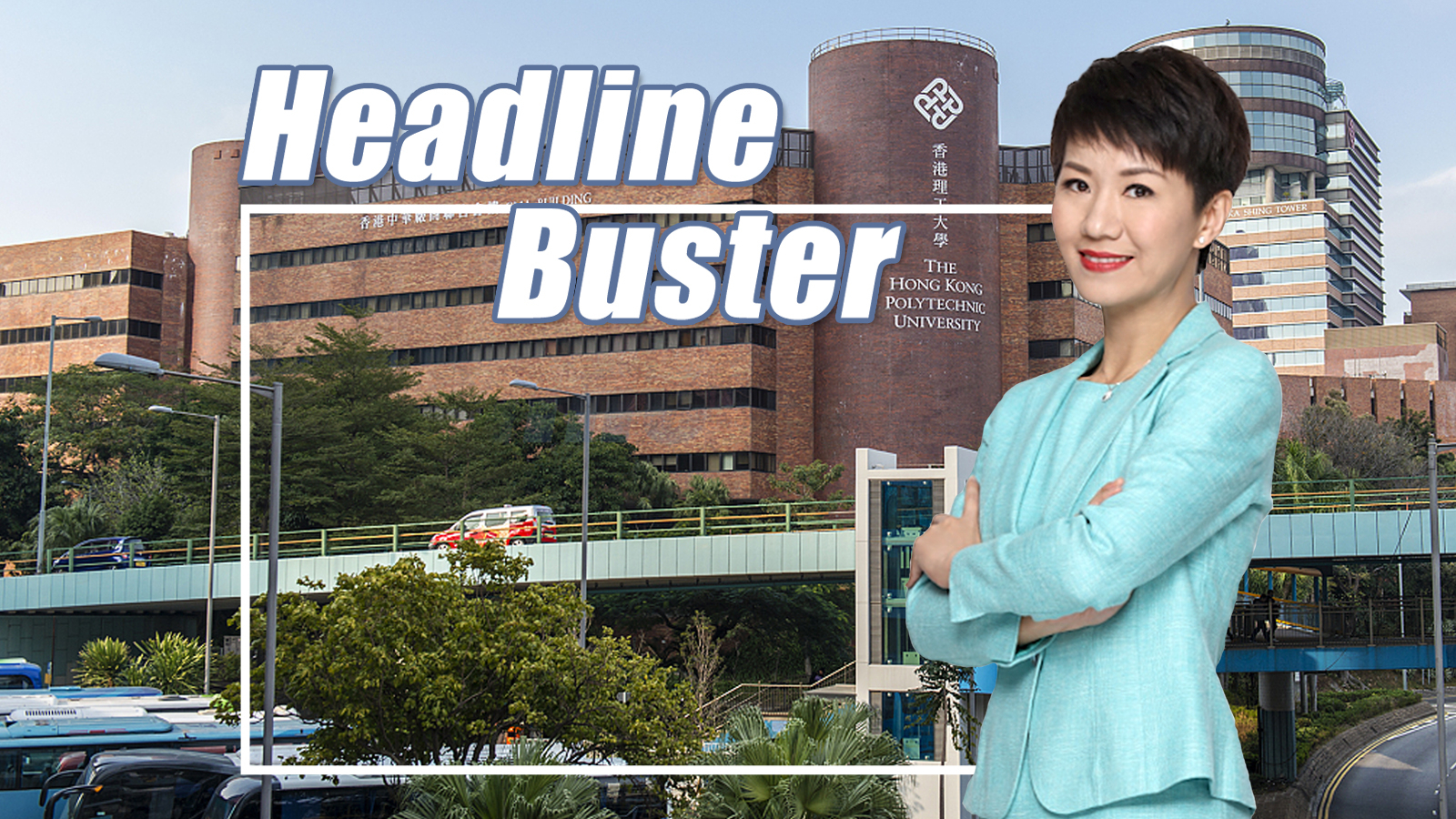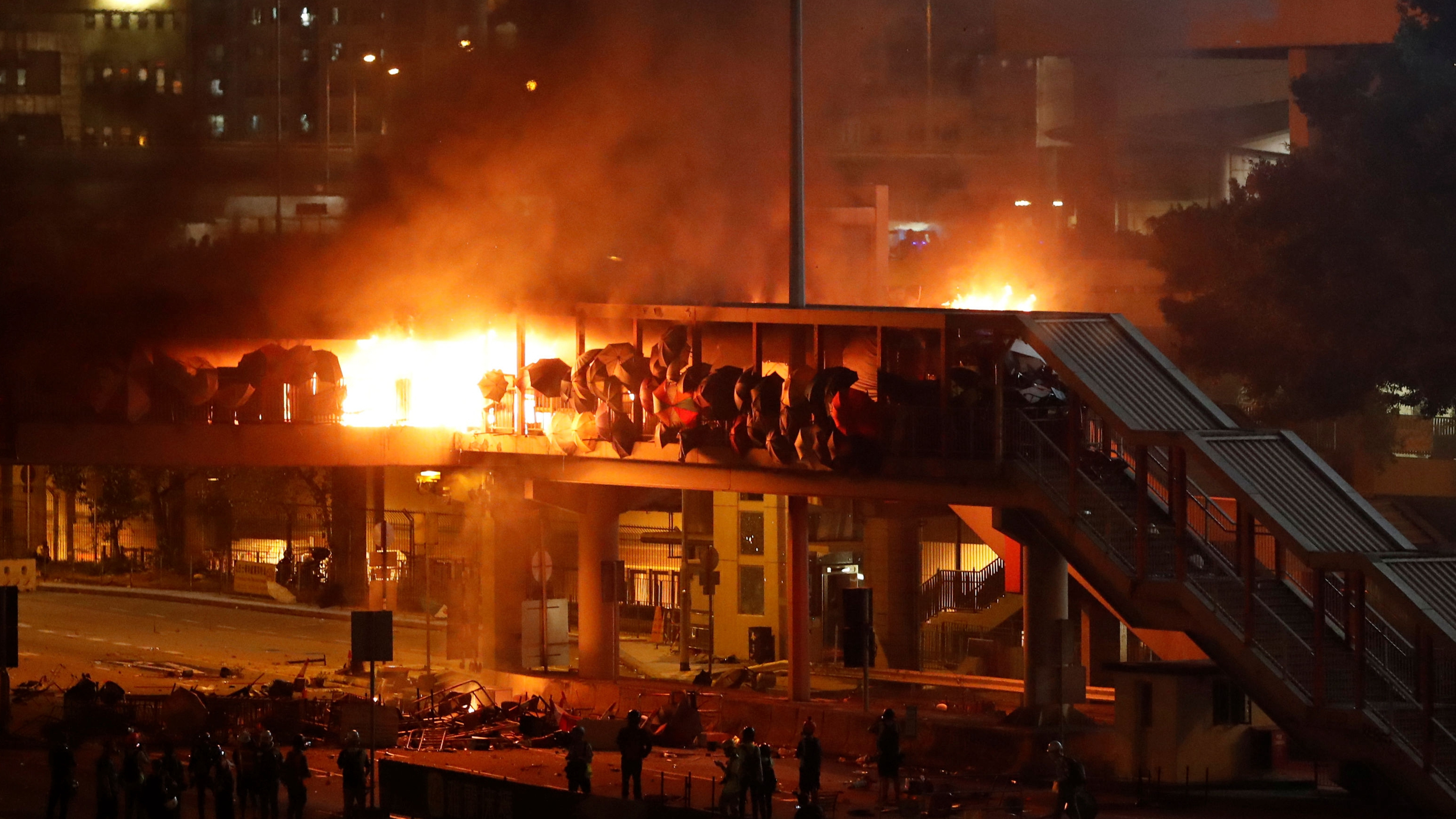10:38

An unknown number of protesters started occupying parts of Hong Kong Polytechnic University campus on Sunday night last week, but the situation escalated on Sunday, as rioters tried to fight off police using a variety of improvised weaponry and dangerous items, including bricks, firebombs, homemade napalm, and bows and arrows. One police officer was injured by an arrow which almost penetrated his leg.
But if you look at the international media coverage, again you might form a different understanding of the situation. For instance, on the campus standoff, you'd think those who occupied the campus were innocent students, or even heroes given the language used by those media outlets to describe the standoff.
On Monday, November 18, the New York Times published a story with the headline: "In Hong Kong, Daring Escapes From a Violent Siege at a University."
"Daring" is defined as "bold, courageous, or adventurous"– all adjectives with positive connotations, as if the students who'd been hoarding "homemade firebombs, giant sling shots, bricks and bows and arrows" inside the campus, according to the article, should be celebrated for their bravery.
Also misleading since the article states that: "Police officers have offered protesters one way out of the Hong Kong Polytechnic University campus, but they fear following those instructions could lead to their arrest," and: "Despite running out of options, the students feared they would be arrested if they obeyed police instructions to 'drop their weapons' and leave through one designated exit."
So actually, there was no need for them to escape. The police offered a way out on the condition that the rioters drop their weapons. Meaning the rioters who tried to escape either did not want to drop their weapons or were afraid of being arrested. But it doesn't really work that way, does it?
What kind of police force would allow rioters to walk out armed with firebombs and bricks? What kind of society would not arrest rioters who hijacked a university, turning it into a weapons factory, and using it as a base to harm police officers? Where in the world would people be allowed to ransack a place and get away with it? By glamorizing those who break the law, whatever the motivations, whether students or not, the New York Times unfortunately failed to tell the true story.
Next example comes from the Washington Post with a story also published on Monday, November 18 and the headline reads: "Hong Kong protesters make last stand as police close in on besieged university." By using "last stand," the headline makes the protesters out to be some sort of gallant heroes who are faced with overwhelming odds.
We need look no further than the first paragraph: "Thousands of Hong Kong protesters flocked to the area around a besieged Hong Kong college campus Monday evening, clashing with police as they tried to help hundreds of students trapped inside to leave safely..."
First of all, many of the people trapped inside were not students at all. So it was premature to characterize them as such. Secondly, when students are armed with bows and arrows, bricks, and stolen chemicals from the school's laboratory among other weapons, can we still call them students?

An elevated walkway burns during clashes between rioters and police outside Hong Kong Polytechnic University in Hong Kong, China, November 17, 2019. /Reuters Photo
An elevated walkway burns during clashes between rioters and police outside Hong Kong Polytechnic University in Hong Kong, China, November 17, 2019. /Reuters Photo
Call them protesters – sure, but "students" give people the impression that they are innocent and vulnerable and thus worthy of people's sympathy. We have seen the damage and harm that have been done by some of these young "students." We all saw the picture of the man who aimed a bow and arrow in full stretch at police; he was clearly an adult with strong muscles.
The article mentions the students are trapped inside 6 times. To me, saying they are "trapped" makes it sound as if they are helpless victims without any option to leave the campus they chose to occupy in the first place.
But the very same article then later explains that the police actually did offer the rioters a way out: "Police blocked exits and told exhausted protesters to come out of the Polytechnic University on Monday to be arrested." And: "Late Monday, a deal was reached between the police and mediators to allow those under 18 still sealed off inside Polytechnic University to leave safely, without arrest."
So these people stayed inside the campus to avoiding arrest. Basically they are trapped by their own criminal behavior. And those under 18 were even given the option to leave without being arrested. But if you didn't take the time to read the entire article, you could easily walk away with only a biased slice of the whole story. By phrasing the beginning of the article this way, the journalist is hinting to the reader who the good guys are and who the bad guys are.
Another story concerns the PLA's clearing of barricades set up the protesters. On Saturday afternoon, People's Liberation Army soldiers stationed in Hong Kong left their barracks in to help clean up rubble that was blocking the city's streets. Members of the PLA have been in Hong Kong since the city was handed back to China in 1997 but have only emerged from their barracks twice in the last 22 years – the first time being last year when they helped in the aftermath of a major typhoon.
The Guardian on November 18 published a story with the headline: "Hong Kong: protesters wary over elite troops clearing roadblocks." The article begins by outlining the events of the day in a rather matter-of-fact way. It adds that when a local journalist asked one of the PLA officers what the group was doing, he responded: "We volunteered! Stopping violence and ending chaos is our responsibility. We are spreading positive energy!"
But the editorializing quickly sets in: "For many in Hong Kong, the message was not a positive one. Pro-democracy activists interpreted it as an attempt to intervene in the city's affairs. Amid Hong Kong's quickly escalating political crisis, anti-government protests that are now in their sixth month, many interpreted it as an ominous warning."
So the article says "many" people interpreted the move as ominous, but then who does the article quote to back up this claim?
On the other hand, what about the local residents who loudly cheered the soldiers when they came out? If not many people cheered, at least some cheered, very loudly and right in front of the eyes of journalists, including that local one who questioned the PLA officer. Somehow the journalist forgot to include the reactions from people. I wonder how they would interpret the move by the soldiers? Maybe an auspicious sign that these soldiers stand with the people of Hong Kong. Maybe something else? But definitely not an ominous warning.
Actually, all this is beside the point – the PLA officers are not the ones threatening the safety and well-being of Hong Kong. The rioters are. This piece of information is, of course, nowhere to be found in the Guardian article.
(If you want to contribute and have specific expertise, please contact us at opinions@cgtn.com)